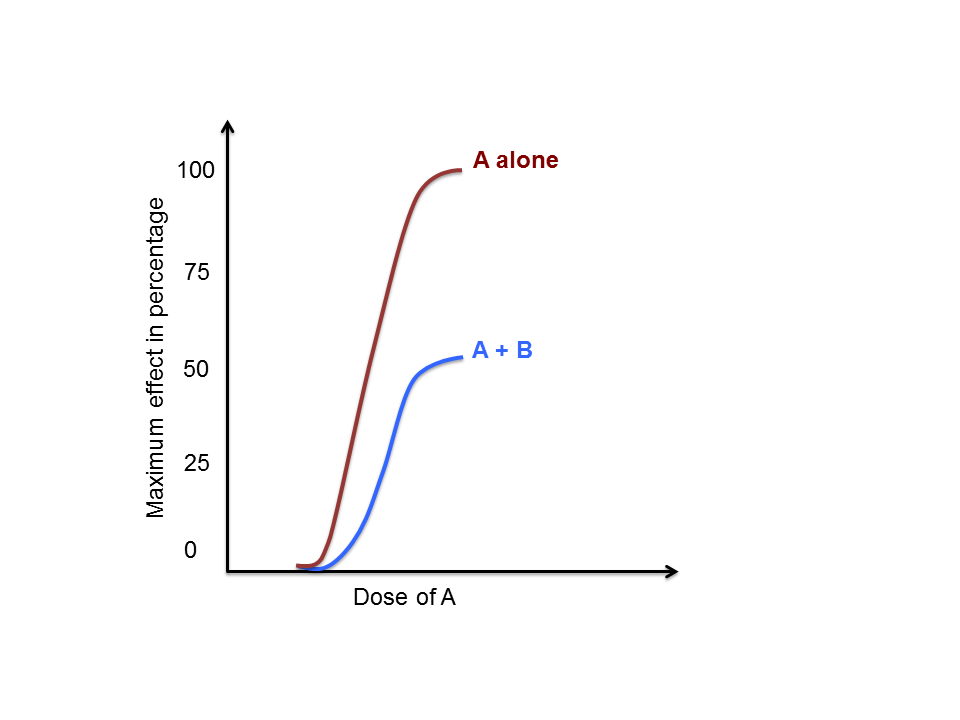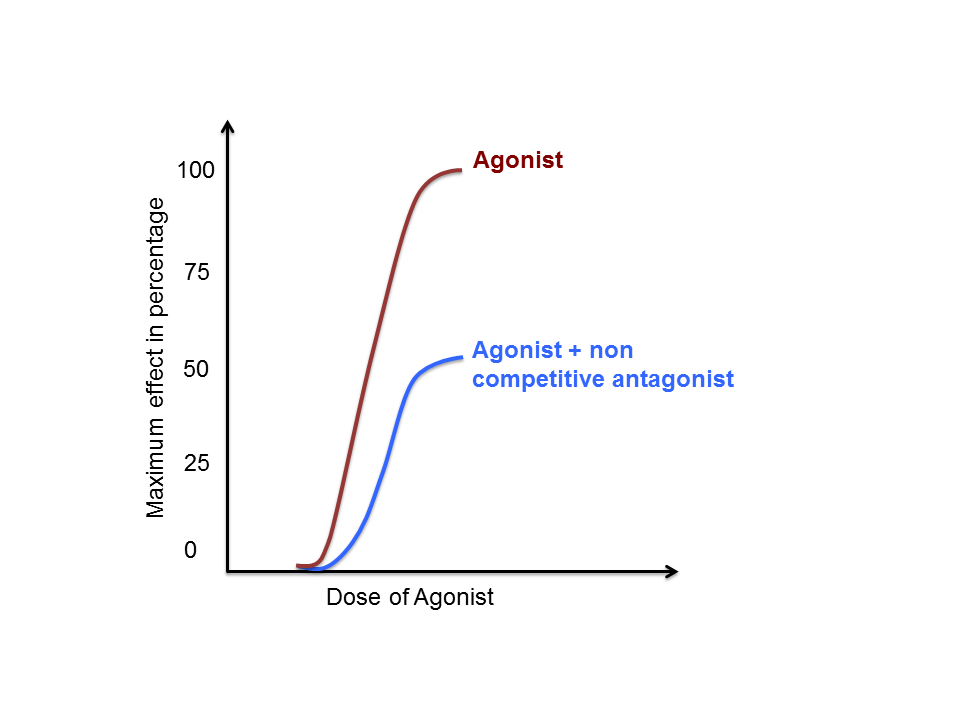WBR0902: Difference between revisions
Rim Halaby (talk | contribs) No edit summary |
Rim Halaby (talk | contribs) No edit summary |
||
| Line 25: | Line 25: | ||
Which of the following combinations has an interaction similar to that of A and B? | Which of the following combinations has an interaction similar to that of A and B? | ||
|Explanation=Efficacy is defined as the maximal effect a drug can produce. While a full agonist produces maximal effect, a partial agonist only leads to less effect when compared to a full agonist. | |Explanation=Efficacy is defined as the maximal effect a drug can produce. While a full agonist produces maximal effect, a partial agonist only leads to less effect when compared to a full agonist. | ||
Potency is defined effect is produced for a given concentration of a drug. The lower the concentration of a substance to produce an effect, the higher the affinity of the substance to the receptor and hence the higher the potency. | Potency is defined effect is produced for a given concentration of a drug. The lower the concentration of a substance to produce an effect, the higher the affinity of the substance to the receptor and hence the higher the potency. | ||
| Line 48: | Line 47: | ||
|AnswerEExp=Phenoxybenzamine is a noncompetitive inhibitor of norepinephrine. An increase in the concentration of norepinephrine is not able to overcome the effect of phenoxybenzamine . | |AnswerEExp=Phenoxybenzamine is a noncompetitive inhibitor of norepinephrine. An increase in the concentration of norepinephrine is not able to overcome the effect of phenoxybenzamine . | ||
|RightAnswer=E | |RightAnswer=E | ||
|WBRKeyword=Antagonist, competitive antagonist, non-competitive antagonist, phenoxybenzamine, Norepinephrine, | |||
|Approved=No | |Approved=No | ||
}} | }} | ||
Revision as of 16:35, 4 December 2013
| Author | [[PageAuthor::Rim Halaby, M.D. [1]]] |
|---|---|
| Exam Type | ExamType::USMLE Step 1 |
| Main Category | MainCategory::Pharmacology |
| Sub Category | SubCategory::General Principles |
| Prompt | [[Prompt::A researcher is investigating the effects of two drugs A and B on blood pressure in rats. The graph below shows the maximal effect of A in decreasing blood pressure when administered alone or when administered in combination with B.
Which of the following combinations has an interaction similar to that of A and B?]] |
| Answer A | [[AnswerA::Naloxone and morphine]] |
| Answer A Explanation | AnswerAExp::Naloxone is a competitive antagonist of morphine. When a competitive antagonist is present, the potency of the agonist is altered and the curve of the effect of the agonist by increasing dose will be shifted towards the right. |
| Answer B | [[AnswerB::Atropine and acetylcholine]] |
| Answer B Explanation | AnswerBExp::Atropine is a competitive antagonist of acetylcholine. When a competitive antagonist is present, the potency of the agonist is altered and the curve of the effect of the agonist by increasing dose will be shifted towards the right. |
| Answer C | [[AnswerC::Haloperidol and dopamine]] |
| Answer C Explanation | AnswerCExp::haloperidol is a competitive antagonist of dopamine. When a competitive antagonist is present, the potency of the agonist is altered and the curve of the effect of the agonist by increasing dose will be shifted towards the right. |
| Answer D | [[AnswerD::Ondansetron and serotonin]] |
| Answer D Explanation | AnswerDExp::Serotonin is a competitive antagonist of ondansetron. When a competitive antagonist is present, the potency of the agonist is altered and the curve of the effect of the agonist by increasing dose will be shifted towards the right. |
| Answer E | [[AnswerE::Noreprinephrine and phenoxybenzamine]] |
| Answer E Explanation | AnswerEExp::Phenoxybenzamine is a noncompetitive inhibitor of norepinephrine. An increase in the concentration of norepinephrine is not able to overcome the effect of phenoxybenzamine . |
| Right Answer | RightAnswer::E |
| Explanation | [[Explanation::Efficacy is defined as the maximal effect a drug can produce. While a full agonist produces maximal effect, a partial agonist only leads to less effect when compared to a full agonist.
Potency is defined effect is produced for a given concentration of a drug. The lower the concentration of a substance to produce an effect, the higher the affinity of the substance to the receptor and hence the higher the potency. According to the figure, when A is alone, a maximal effect is produced. However, when A and B are combined the curve is shifted downwards depicting decreased efficacy. An increase in the concentration of A was not able to overcome the effect of B on the efficacy. Hence B is a non-competitive inhibitor. Phenoxybenzamine is a noncompetitive inhibitor of norepinephrine. Shown below are graphs depicting competitive and non competitive antagonists: Educational objective: |
| Approved | Approved::No |
| Keyword | WBRKeyword::Antagonist, WBRKeyword::competitive antagonist, WBRKeyword::non-competitive antagonist, WBRKeyword::phenoxybenzamine, WBRKeyword::Norepinephrine |
| Linked Question | Linked:: |
| Order in Linked Questions | LinkedOrder:: |



